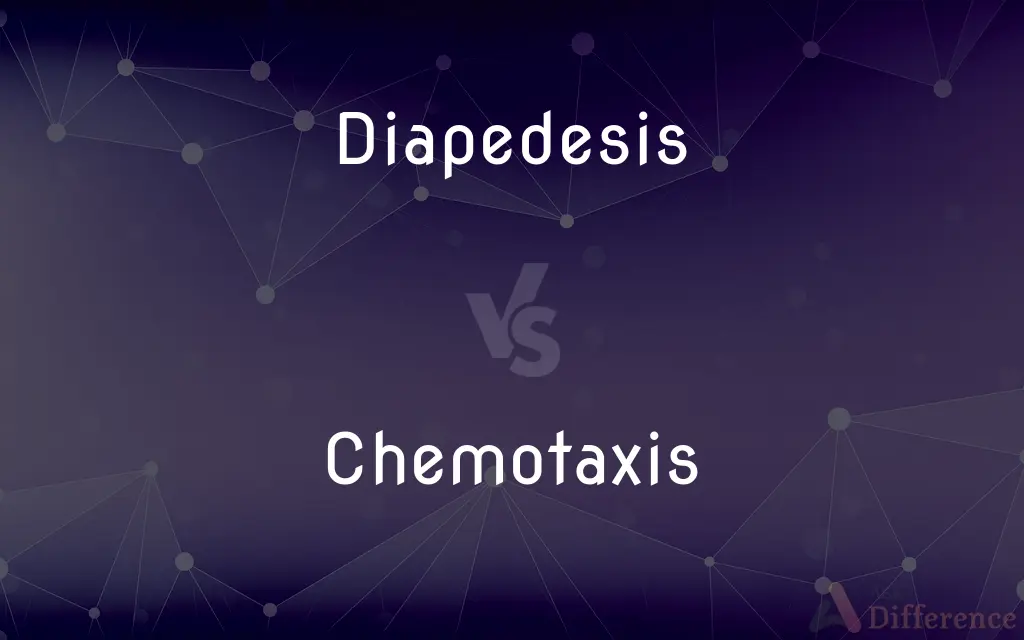Diapedesis vs. Chemotaxis — What's the Difference?
By Urooj Arif & Maham Liaqat — Updated on April 15, 2024
Diapedesis is the process where body cells move through vessel walls into tissues, critical in immune responses, while chemotaxis is the movement of cells towards chemical signals, guiding cells to sites of injury or infection.

Difference Between Diapedesis and Chemotaxis
Table of Contents
ADVERTISEMENT
Key Differences
Diapedesis involves the squeezing of body cells, particularly leukocytes, through the endothelial cells of blood vessel walls to reach body tissues. This is essential during inflammatory responses to combat infection. On the other hand, chemotaxis refers to the movement of cells, including bacteria, leukocytes, and other cell types, directed by chemical gradients, which are often signals released by damaged cells or pathogens.
The mechanism of diapedesis includes interactions between cellular adhesion molecules on leukocytes and endothelial cells, facilitating the leukocytes’ traversal through the vessel wall. Whereas chemotaxis relies on the ability of cells to sense and move towards higher concentrations of specific chemicals, using receptors that bind to signaling molecules, guiding their path.
Diapedesis is primarily associated with the immune response, allowing immune cells to exit the bloodstream and enter affected tissues where they are needed. In contrast, chemotaxis can be seen in various biological processes, including immune responses, embryonic development, and cancer metastasis, where cells migrate according to chemical cues.
The regulation of diapedesis involves several steps, including the tethering, rolling, adhesion, and transmigration of leukocytes, which are tightly controlled by cytokines and other signaling molecules. Chemotaxis, however, is regulated by chemokines and other chemoattractants that create a gradient guiding cells to specific locations.
In terms of application, understanding diapedesis can help in developing treatments for inflammatory diseases by potentially targeting the pathways involved in leukocyte migration. Chemotaxis plays a critical role in targeted therapies in oncology and wound healing, where manipulating cellular movement can enhance treatment efficacy.
ADVERTISEMENT
Comparison Chart
Definition
Movement of cells through vessel walls
Movement of cells towards chemical signals
Key Cells Involved
Leukocytes
Various cell types, including leukocytes
Primary Biological Process
Inflammatory response
Various, including immune response and development
Mechanism
Involves adhesion molecules
Directed by chemical gradients
Application in Medicine
Targets for anti-inflammatory drugs
Targets for cancer and wound healing therapies
Compare with Definitions
Diapedesis
Immune response.
Diapedesis is crucial for allowing white blood cells to fight infections in tissue.
Chemotaxis
Cell movement.
Chemotaxis is the mechanism by which cells move toward higher concentrations of chemicals.
Diapedesis
Inflammation.
Diapedesis is a vital component of the inflammatory process.
Chemotaxis
Guided migration.
Chemotaxis guides immune cells to sites of infection.
Diapedesis
Cellular adhesion.
Cellular adhesion molecules play a key role in diapedesis.
Chemotaxis
Developmental processes.
Chemotaxis is important in embryonic development.
Diapedesis
Transmigration.
During diapedesis, leukocytes transmigrate across the endothelium.
Chemotaxis
Signal response.
Cells respond to chemotactic signals to locate areas of injury.
Diapedesis
Vascular permeability.
Diapedesis increases vascular permeability during inflammation.
Chemotaxis
Pathogen tracking.
Neutrophils use chemotaxis to track and eliminate pathogens.
Chemotaxis
Chemotaxis (from chemo- + taxis) is the movement of an organism or entity in response to a chemical stimulus. Somatic cells, bacteria, and other single-cell or multicellular organisms direct their movements according to certain chemicals in their environment.
Chemotaxis
The characteristic movement or orientation of an organism or cell along a chemical concentration gradient either toward or away from the chemical stimulus.
Chemotaxis
The movement of a cell or an organism in response to a chemical stimulant.
Chemotaxis
The sensitiveness exhibited by small free-swimming organisms, as bacteria, zoöspores of algæ, etc., to chemical substances held in solution. They may be attracted (positive chemotaxis) or repelled (negative chemotaxis).
Chemotaxis
Movement by a cell or organism in reaction to a chemical stimulus
Common Curiosities
What are some examples of chemokines?
Examples of chemokines include interleukins and lymphokines that guide cell movement.
How do cells detect chemical gradients in chemotaxis?
Cells detect chemical gradients through surface receptors that sense the concentration of chemicals.
Can diapedesis occur with all types of cells?
Diapedesis primarily involves leukocytes, not all types of cells.
Is diapedesis a form of cellular movement?
Yes, diapedesis is a specific form of cellular movement involving the migration through vessel walls.
Can chemotaxis be artificially manipulated?
Yes, manipulating chemotaxis is a strategy in developing treatments for diseases like cancer.
Can diapedesis be targeted by drugs?
Yes, targeting the pathways involved in diapedesis can help manage inflammatory diseases.
What triggers diapedesis?
Diapedesis is triggered by inflammatory signals and interactions between leukocytes and endothelial cells.
Are chemotactic factors always beneficial?
Chemotactic factors can be beneficial in wound healing and defense against infections, but can also play a role in disease processes like arthritis.
How does diapedesis affect tissue health?
Diapedesis is crucial in delivering immune cells to sites of infection, aiding in tissue recovery.
What role does chemotaxis play in cancer?
Chemotaxis can influence cancer metastasis by guiding cancer cells to new locations.
What is the difference between chemotaxis and taxis?
Chemotaxis is a type of taxis specifically involving chemical stimuli.
What is the clinical significance of understanding diapedesis?
Understanding diapedesis helps in developing therapies for conditions where immune cell migration plays a critical role.
Does chemotaxis involve only leukocytes?
No, chemotaxis can involve a variety of cells, including bacteria and other microorganisms.
How does diapedesis contribute to immune surveillance?
Diapedesis allows immune cells to patrol tissues and detect pathogens or damage.
What regulates chemotaxis?
Chemotaxis is regulated by chemical gradients formed by chemokines and other signaling molecules.
Share Your Discovery

Previous Comparison
Future vs. Upcoming
Next Comparison
Conformed vs. NotedAuthor Spotlight
Written by
Urooj ArifUrooj is a skilled content writer at Ask Difference, known for her exceptional ability to simplify complex topics into engaging and informative content. With a passion for research and a flair for clear, concise writing, she consistently delivers articles that resonate with our diverse audience.
Co-written by
Maham Liaqat















































